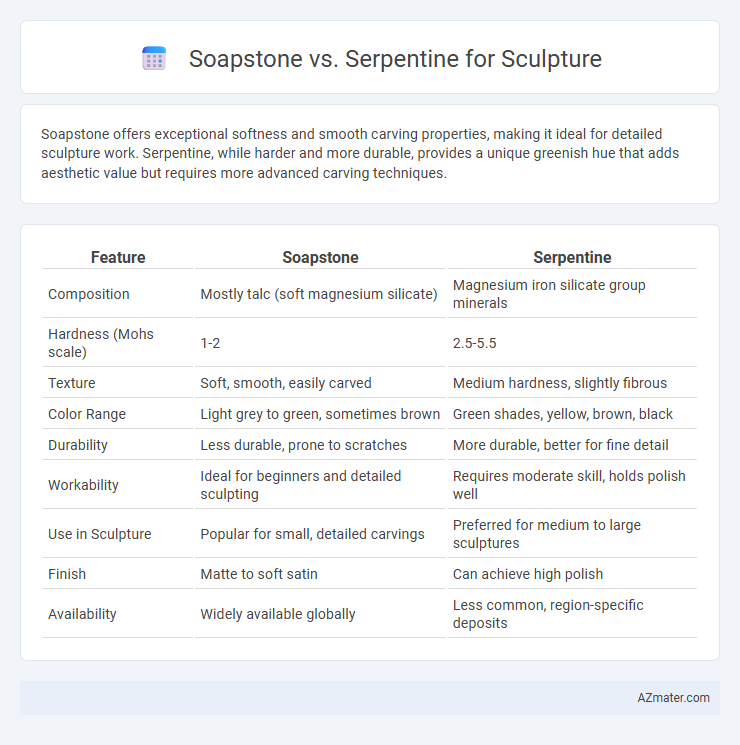Soapstone offers exceptional softness and smooth carving properties, making it ideal for detailed sculpture work. Serpentine, while harder and more durable, provides a unique greenish hue that adds aesthetic value but requires more advanced carving techniques.
Table of Comparison
| Feature | Soapstone | Serpentine |
|---|---|---|
| Composition | Mostly talc (soft magnesium silicate) | Magnesium iron silicate group minerals |
| Hardness (Mohs scale) | 1-2 | 2.5-5.5 |
| Texture | Soft, smooth, easily carved | Medium hardness, slightly fibrous |
| Color Range | Light grey to green, sometimes brown | Green shades, yellow, brown, black |
| Durability | Less durable, prone to scratches | More durable, better for fine detail |
| Workability | Ideal for beginners and detailed sculpting | Requires moderate skill, holds polish well |
| Use in Sculpture | Popular for small, detailed carvings | Preferred for medium to large sculptures |
| Finish | Matte to soft satin | Can achieve high polish |
| Availability | Widely available globally | Less common, region-specific deposits |
Introduction to Soapstone and Serpentine
Soapstone is a soft, talc-rich metamorphic rock favored by sculptors for its smooth texture and ease of carving. Serpentine, a group of greenish minerals, offers greater hardness and durability, making it suitable for detailed, long-lasting sculptures. Both materials feature unique veining and coloration that enhance artistic expression in stone carving.
Geological Origins and Composition
Soapstone, primarily composed of talc with varying amounts of chlorite, magnesite, and amphiboles, originates from metamorphic processes involving altered ultramafic rocks, resulting in a soft, workable material favored for fine sculpture detail. Serpentine, a group of minerals including chrysotile and antigorite, forms through the hydration and metamorphism of ultramafic rocks, producing a harder stone that often features distinct green hues and complex veining, influencing both its aesthetic and carving techniques. The key difference in geological origins lies in soapstone's talc-rich composition that imparts softness and heat resistance, while serpentine's magnesium silicate structure offers greater hardness and color variation beneficial for durable, vibrant sculptures.
Visual Appearance and Color Variations
Soapstone offers a smooth, matte finish with colors ranging from creamy white and pale green to deep brown and charcoal, providing subtle, natural tones ideal for detailed sculptures. Serpentine features a glossy surface with vibrant green hues often interspersed with black or white veining, creating dynamic visual contrasts that highlight intricate carving details. The color variability in serpentine tends to be more striking and varied, making it suitable for sculptures meant to capture attention through vivid coloration.
Workability and Carving Ease
Soapstone offers superior workability and carving ease due to its soft, talc-rich composition, allowing sculptors to shape detailed forms with hand tools effortlessly. Serpentine is harder and denser, requiring more effort and specialized tools to carve, making it less ideal for beginners but suitable for artists seeking a more durable finish. The choice depends on the sculptor's skill level and desired final texture, with soapstone favored for smooth, intricate designs and serpentine for robust, polished pieces.
Durability and Longevity
Soapstone offers moderate durability and is favored for its softness and ease of carving, making it suitable for detailed sculptures, but it is more prone to scratching and weathering than harder stones. Serpentine exhibits greater hardness and resistance to abrasion, providing enhanced longevity and durability in outdoor and high-wear environments, making it ideal for sculptures requiring long-term preservation. Both materials require proper sealing to protect against moisture and environmental damage, with serpentine generally maintaining structural integrity better over extended periods.
Cost and Accessibility
Soapstone is generally more affordable and widely available compared to serpentine, making it a popular choice for sculptors seeking cost-effective materials. Serpentine tends to be pricier due to its limited deposits and more challenging extraction process. Accessibility to soapstone is higher, with numerous quarries worldwide, while quality serpentine is rarer and often region-specific, impacting its availability and overall cost.
Finishing Techniques and Surface Texture
Soapstone offers a smooth, fine-grained surface that is ideal for detailed carving and polishing, resulting in a silky finish prized in sculpture. Serpentine, with its varied hardness and fibrous texture, requires careful sanding and sealing to achieve a glossy or matte surface but can reveal striking color variations and patterns. Both materials respond differently to abrasives and sealers, influencing the final tactile quality and visual depth of the sculpture.
Popular Uses in Sculpture Art
Soapstone is favored in sculpture art for its softness and smooth texture, making it ideal for detailed carving and beginner sculptors. Serpentine, known for its varied color palette and slight hardness, is popular for intricate, polished sculptures and jewelry pieces. Both materials are celebrated for their workability and aesthetic appeal in creating durable, artistic sculptures.
Health and Safety Considerations
Soapstone is generally safer for sculptors due to its low silica content, reducing the risk of silicosis from inhaling dust. Serpentine contains chrysotile asbestos fibers, posing significant respiratory hazards if dust is inhaled during carving. Proper respiratory protection and dust control measures are essential when working with serpentine to prevent long-term health issues.
Choosing the Right Stone for Your Project
Selecting between soapstone and serpentine for sculpting depends on their hardness and workability; soapstone, being softer (Mohs hardness 1-2), allows for easier carving and detailed work, ideal for beginners or intricate projects. Serpentine is harder (Mohs hardness 3-6), offering durability and a polished finish but requiring more advanced tools and skills. Consider the project's scale, desired finish, and your carving expertise to choose the stone that best matches your artistic vision and practical needs.

Infographic: Soapstone vs Serpentine for Sculpture
 azmater.com
azmater.com